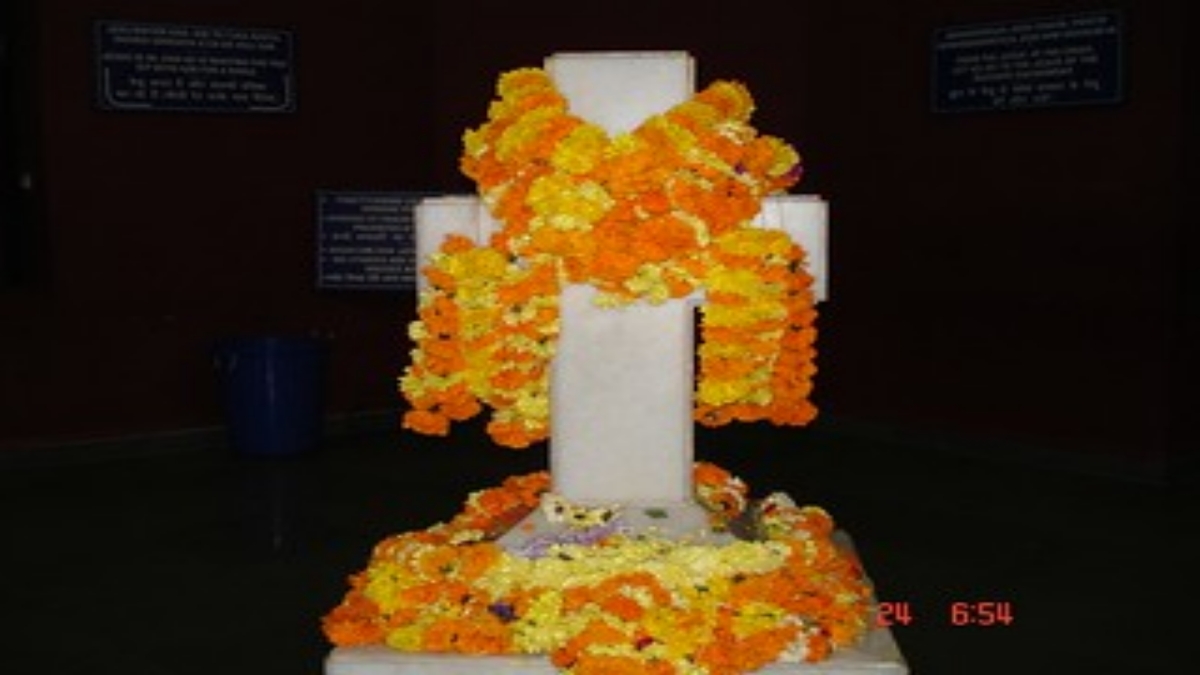The plateau which some 60 years ago hosted a thick forest is today changed into a township. As high-rise apartment blocks compete with fascinating bungalows on the plateau of Bambolim, an eye-catching Shrine has also made its presence felt. Till recently, the place was famous for the Fulancho Khuris (Cross of Flowers), but today a shrine dedicated to this Cross was officially blessed at the hands of Archbishop Raul Gonsalves.

Fulancho Khuris is famous not only through every nook and corner of Goa but even across its borders. Standing by the side of National Highway 14, it is a common spot to see travelers stop their vehicles and pay obeisance to the Cross. With the commissioning of Goa Medical College nearby, patients and their relatives also stop by the Cross to seek holy intervention for a speedy recovery. The Holy Cross is also worshipped by residents of the military camp nearby.
It is because of these instances, that the Cross has today become a place of pilgrimage with people from distant places coming to offer their prayers and seek divine intervention to fulfill their desires or to rid them of their problems. People of all religions are seen at the Cross offering prayers or thanksgiving. Many persons offer thanksgiving masses for favors granted. Little wonder then in more recent times the Cross is known as MILAGRINCHO KHURIS (Miraculous Cross).
Flowers and the Cross (Fulancho Khuris)
The Cross gets the name – Fulancho Khuris, because it is always covered with bright colored local flowers like marigold (Abolim and Rosam). The flowers are sold by different community people near the Cross. Once again Ana Maria has an explanation. In the days gone by, around Bambolim lived Gawdas who had renounced Christianity to which they were converted. Women from this community who died during the pregnancy or during childbirth were buried near the Cross. Their graves were covered with colorful flowers, mostly Abolim and Rosam.
After renouncing Christianity this community still continued to offer litanies before the Cross and at these times the Cross would be covered with colorful flowers. Not so surprising then that today there are women and men from the same community selling the flowers near the Cross. That the people who renounced Christianity continue to offer prayers at the Cross and Christian symbols of worship is evident at Carambolim where the Gawdas offer a litany at a chapel in their ward and invite Catholics from the village to participate. A similar practice was followed at Palle in Siridao till recently.
The Shrine
When the parish priest Fr. Freddy J. Da Costa at that time decided to construct the Shrine, he resolved not to accept any donations from foreign agencies. The imposing and magnificent structure that one sees today is constructed at the cost of around 70 lakhs which may have even touched a crore by the time the full project was completed. What is surprising is that the entire amount came from the faithful and devotees of the Cross.
The foundation stone for the Shrine was laid on May 21, 1995, by Archbishop Raul Gonsalves and the work started in September the same year. Within a year the Shrine was completed, which in itself is a miracle.
Noted Architect Ralino de Souza designed the Shrine to give it a unique ambiance. While the exterior is imposing the interior is equally fascinating with its two-tier system. The lower level faces the alter while the back has an elevated portion. This has been done so that all present in the Shrine may get a good view of the altar (behind which a life-size statue of Christ smiles at the gathering) and concentrate on the service.
Constructed by S. N. Constructions from Vasco, the Shrine was blessed on 13 October 1996 by the Msgr. Raul N. Gonsalves at 10 a.m.
The Cross Evolution
With the military camp coming up, the faithful in the army needed a place of worship and hence the Bambolim Cross nearby became a place of worship. Fr. Raul Inacio during his tenure as the Parish Priest of Bambolim began offering masses at the Cross.
Later Fr. Filipino Rebello expanded the area for mass and later Fr. Ariston Dias began the practice of regular mass on Sundays at the Cross. Fr. Napolean Silveira spending Rs. 3,00,000 constructed a shamiana behind the Cross from where people could participate in the Mass.
Trivia
According to Ana Maria, near the Cross, there was a structure which was called “Dovornnem or Thevnnem” in Goan native language Konkani. This type of structure is quite common along Goan roadsides, particularly roads connecting two villages. These structures were basically used by people carrying a load on their heads. The basket would be kept on the structure while the person rested for a while.
The structure was always elevated so that the person did not have much difficulty in either lowering the load or taking it back on the head.
Near the Bambolim Cross, a similar structure existed in the by-gone days and people who would stop there for a breather would also pray before the Cross.


